
The S-Bahn is a hybrid urban-suburban rail system serving a metropolitan region predominantly in German-speaking countries. Some of the larger S-Bahn systems provide service similar to rapid transit systems, while smaller ones often resemble commuter or even regional rail systems. The name S-Bahn derives from Schnellbahn, Stadtbahn or Stadtschnellbahn.
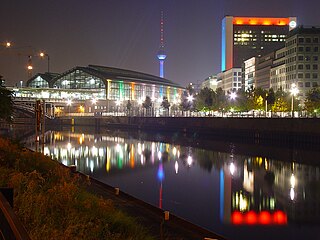
The Berlin S-Bahn is a rapid transit railway system in and around Berlin, the capital city of Germany. It has been in operation under this name since December 1930, having been previously called the special tariff area Berliner Stadt-, Ring- und Vorortbahnen. It complements the Berlin U-Bahn and is the link to many outer-Berlin areas, such as Berlin Brandenburg Airport. As such, the Berlin S-Bahn blends elements of a commuter rail service and a rapid transit system.
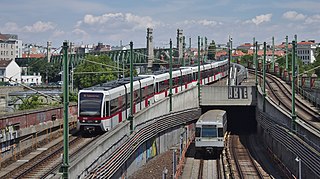
The Vienna U-Bahn, where U-Bahn is an abbreviation of the German word Untergrundbahn, is a rapid transit system serving Vienna, Austria. The five-line network consists of 83.1 kilometers (51.6 mi) of route, serving 109 stations. It is the backbone of what the International Association of Public Transport (UITP) deemed one of the best-performing public transport systems worldwide in 2009. 459.8 million passengers rode the U-Bahn in 2019. The network is undergoing expansion and rolling stock renewal. Since 1969, 200 million euros have been invested annually in the extension of the Vienna U-Bahn.

The Munich S-Bahn is an electric rail transit system in Munich, Germany. "S-Bahn" is the German abbreviation for Stadtschnellbahn, and the Munich S-Bahn exhibits characteristics of both rapid transit and commuter rail systems.

Wiener Linien is the company running most of the public transit network in the city of Vienna, Austria. It is part of the city corporation Wiener Stadtwerke.

Vienna has an extensive transport system that includes roads, railways, trams, metro, and buses.

The Vienna S-Bahn is a suburban commuter rail network in Vienna, Austria. As opposed to the city-run urban metro network, the Vienna U-Bahn, it extends beyond the borders of the city, is operated by the ÖBB, and consists of many branch lines. S-Bahn is short for Schnellbahn, which can be translated as "rapid railway".

The Vienna Stadtbahn was a rail-based public transportation system operated under this name from 1898 until 1989. Today, the Vienna U-Bahn lines U4 and U6 and the Vienna S-Bahn run on its former lines.

Bonn Hauptbahnhof is a railway station located on the left bank of the Rhine along the Cologne–Mainz line. It is the principal station serving the city of Bonn. In addition to extensive rail service from Deutsche Bahn it acts as a hub for local bus, tram, and Stadtbahn services.

Berlin-Spandau station is a Deutsche Bahn station in the Berlin district of Spandau on the south-western edge of the old town of Spandau. The railway junction station is one of the 80 stations classified by Deutsche Bahn as a category 2 station. It has the longest train shed in Germany.
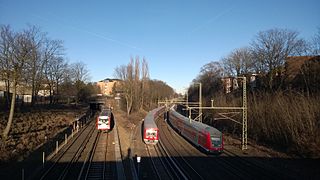
Rapid transit in Germany consists of four U-Bahn systems and fourteen S-Bahn systems. The U-Bahn commonly understood to stand for Untergrundbahn are conventional rapid transit systems that run mostly underground, while the S-Bahn or Stadtschnellbahn are commuter rail services, that may run underground in the city center and have metro-like characteristics in Munich, Hamburg and Berlin which they only have to a lesser extent in other cities. There are also over a dozen premetro or Stadtbahn systems that are rapid transit in the city center and light rail outside.

The Berlin–Lehrte railway, known in German as the Lehrter Bahn, is an east–west line running from Berlin via Lehrte to Hanover. Its period as a separate railway extended from its opening in 1871 to the nationalisation of its owner, the Magdeburg-Halberstadt Railway Company on 1 July 1886. The company's Berlin station, the Lehrter Bahnhof was finally torn down in 1958.
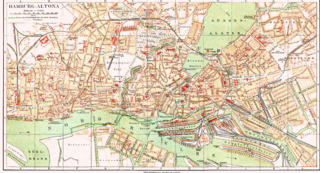
The Hamburg-Altona link line is a railway line in Hamburg, Germany. It now connects the lines from the north and west of Hamburg and Altona station with Hamburg Hauptbahnhof and the lines to the south and east. It was initially designed as a freight line only but is it now one of the busiest lines in Germany. It includes the suburban tracks of the Hamburg Stadtbahn, originally the core of the Hamburg S-Bahn.

The Karlsruhe–Mühlacker railway is a railway line in the west of the German state of Baden-Württemberg. It was built between 1859 and 1863 and is one of the oldest railways in Germany. It was built as the second connection between the networks of the Grand Duchy of Baden State Railway and the Royal Württemberg State Railways and it still constitutes an important east–west route in southern Germany.

Wien Mitte is a rail and U-Bahn station in Vienna, close to the city centre. It is the city terminus of Vienna's City Airport Train (CAT), which provides non-stop service to Vienna International Airport. The station is a major hub for S-Bahn suburban trains, with little service by InterCity trains. The station is connected to the Landstraße U-Bahn station.

Ottakring is a station on U3 of the Vienna U-Bahn. Beside the U-Bahn station is the Wien Ottakring railway station, which is served by line S45 of the Vienna S-Bahn.

Hütteldorf is a station on U4 of the Vienna U-Bahn. The U-Bahn station is housed within a train shed at the Wien Hütteldorf railway station, which is also served by long distance and regional trains, and by Vienna S-Bahn lines S45, S50 and S60.
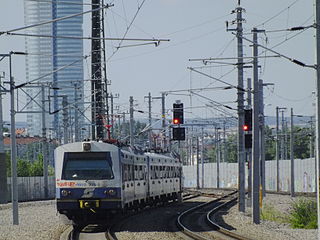
S1 of the Vienna S-Bahn is an electrified commuter rail service operating between Gänserndorf and Wien Meidling.
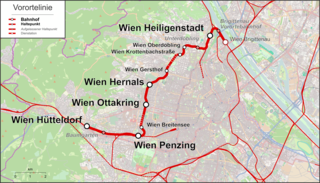
The Suburban line is a railway line in the city of Vienna. It runs approximately 14 kilometres (8.7 mi) from Wien Hütteldorf to Wien Heiligenstadt, running around the northwest side of the city. It hosts the S45 service of the Vienna S-Bahn.

The Donauuferbahn is a railway line in Vienna, Austria. It runs 12.8 kilometres (8.0 mi) along the west bank of the Danube river. At the northern end, the line connects with the Franz-Josefs-Bahn and Suburban line. At the southern end, the line continues as the Donauländebahn near the Winterhafenbrücke. The line is owned and operated by Austrian Federal Railways (ÖBB) and is mostly freight-only.





















